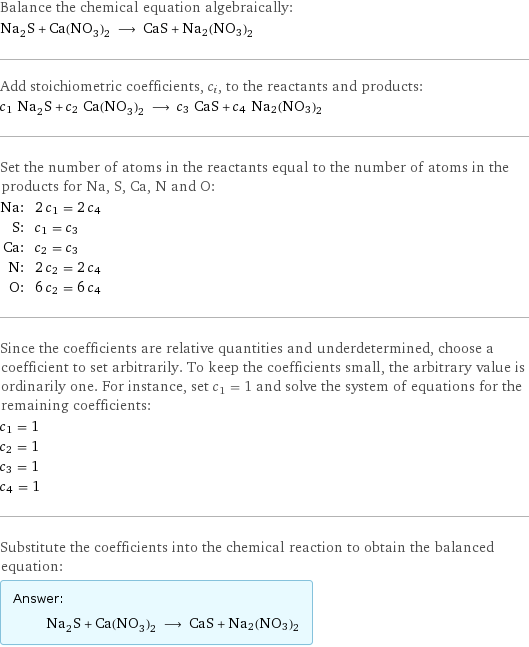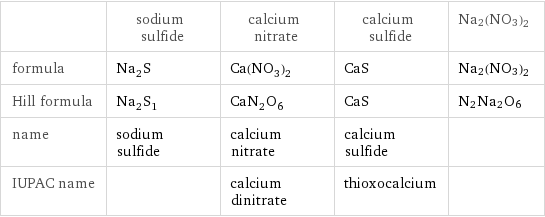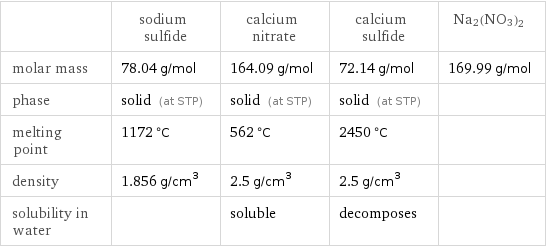Input interpretation

Na_2S sodium sulfide + Ca(NO_3)_2 calcium nitrate ⟶ CaS calcium sulfide + Na2(NO3)2
Balanced equation

Balance the chemical equation algebraically: Na_2S + Ca(NO_3)_2 ⟶ CaS + Na2(NO3)2 Add stoichiometric coefficients, c_i, to the reactants and products: c_1 Na_2S + c_2 Ca(NO_3)_2 ⟶ c_3 CaS + c_4 Na2(NO3)2 Set the number of atoms in the reactants equal to the number of atoms in the products for Na, S, Ca, N and O: Na: | 2 c_1 = 2 c_4 S: | c_1 = c_3 Ca: | c_2 = c_3 N: | 2 c_2 = 2 c_4 O: | 6 c_2 = 6 c_4 Since the coefficients are relative quantities and underdetermined, choose a coefficient to set arbitrarily. To keep the coefficients small, the arbitrary value is ordinarily one. For instance, set c_1 = 1 and solve the system of equations for the remaining coefficients: c_1 = 1 c_2 = 1 c_3 = 1 c_4 = 1 Substitute the coefficients into the chemical reaction to obtain the balanced equation: Answer: | | Na_2S + Ca(NO_3)_2 ⟶ CaS + Na2(NO3)2
Structures

+ ⟶ + Na2(NO3)2
Names

sodium sulfide + calcium nitrate ⟶ calcium sulfide + Na2(NO3)2
Equilibrium constant
![Construct the equilibrium constant, K, expression for: Na_2S + Ca(NO_3)_2 ⟶ CaS + Na2(NO3)2 Plan: • Balance the chemical equation. • Determine the stoichiometric numbers. • Assemble the activity expression for each chemical species. • Use the activity expressions to build the equilibrium constant expression. Write the balanced chemical equation: Na_2S + Ca(NO_3)_2 ⟶ CaS + Na2(NO3)2 Assign stoichiometric numbers, ν_i, using the stoichiometric coefficients, c_i, from the balanced chemical equation in the following manner: ν_i = -c_i for reactants and ν_i = c_i for products: chemical species | c_i | ν_i Na_2S | 1 | -1 Ca(NO_3)_2 | 1 | -1 CaS | 1 | 1 Na2(NO3)2 | 1 | 1 Assemble the activity expressions accounting for the state of matter and ν_i: chemical species | c_i | ν_i | activity expression Na_2S | 1 | -1 | ([Na2S])^(-1) Ca(NO_3)_2 | 1 | -1 | ([Ca(NO3)2])^(-1) CaS | 1 | 1 | [CaS] Na2(NO3)2 | 1 | 1 | [Na2(NO3)2] The equilibrium constant symbol in the concentration basis is: K_c Mulitply the activity expressions to arrive at the K_c expression: Answer: | | K_c = ([Na2S])^(-1) ([Ca(NO3)2])^(-1) [CaS] [Na2(NO3)2] = ([CaS] [Na2(NO3)2])/([Na2S] [Ca(NO3)2])](../image_source/34914f09f77557119ee10130bd9f1bc2.png)
Construct the equilibrium constant, K, expression for: Na_2S + Ca(NO_3)_2 ⟶ CaS + Na2(NO3)2 Plan: • Balance the chemical equation. • Determine the stoichiometric numbers. • Assemble the activity expression for each chemical species. • Use the activity expressions to build the equilibrium constant expression. Write the balanced chemical equation: Na_2S + Ca(NO_3)_2 ⟶ CaS + Na2(NO3)2 Assign stoichiometric numbers, ν_i, using the stoichiometric coefficients, c_i, from the balanced chemical equation in the following manner: ν_i = -c_i for reactants and ν_i = c_i for products: chemical species | c_i | ν_i Na_2S | 1 | -1 Ca(NO_3)_2 | 1 | -1 CaS | 1 | 1 Na2(NO3)2 | 1 | 1 Assemble the activity expressions accounting for the state of matter and ν_i: chemical species | c_i | ν_i | activity expression Na_2S | 1 | -1 | ([Na2S])^(-1) Ca(NO_3)_2 | 1 | -1 | ([Ca(NO3)2])^(-1) CaS | 1 | 1 | [CaS] Na2(NO3)2 | 1 | 1 | [Na2(NO3)2] The equilibrium constant symbol in the concentration basis is: K_c Mulitply the activity expressions to arrive at the K_c expression: Answer: | | K_c = ([Na2S])^(-1) ([Ca(NO3)2])^(-1) [CaS] [Na2(NO3)2] = ([CaS] [Na2(NO3)2])/([Na2S] [Ca(NO3)2])
Rate of reaction
![Construct the rate of reaction expression for: Na_2S + Ca(NO_3)_2 ⟶ CaS + Na2(NO3)2 Plan: • Balance the chemical equation. • Determine the stoichiometric numbers. • Assemble the rate term for each chemical species. • Write the rate of reaction expression. Write the balanced chemical equation: Na_2S + Ca(NO_3)_2 ⟶ CaS + Na2(NO3)2 Assign stoichiometric numbers, ν_i, using the stoichiometric coefficients, c_i, from the balanced chemical equation in the following manner: ν_i = -c_i for reactants and ν_i = c_i for products: chemical species | c_i | ν_i Na_2S | 1 | -1 Ca(NO_3)_2 | 1 | -1 CaS | 1 | 1 Na2(NO3)2 | 1 | 1 The rate term for each chemical species, B_i, is 1/ν_i(Δ[B_i])/(Δt) where [B_i] is the amount concentration and t is time: chemical species | c_i | ν_i | rate term Na_2S | 1 | -1 | -(Δ[Na2S])/(Δt) Ca(NO_3)_2 | 1 | -1 | -(Δ[Ca(NO3)2])/(Δt) CaS | 1 | 1 | (Δ[CaS])/(Δt) Na2(NO3)2 | 1 | 1 | (Δ[Na2(NO3)2])/(Δt) (for infinitesimal rate of change, replace Δ with d) Set the rate terms equal to each other to arrive at the rate expression: Answer: | | rate = -(Δ[Na2S])/(Δt) = -(Δ[Ca(NO3)2])/(Δt) = (Δ[CaS])/(Δt) = (Δ[Na2(NO3)2])/(Δt) (assuming constant volume and no accumulation of intermediates or side products)](../image_source/d377368c73905c5a4243ded81f1d5a26.png)
Construct the rate of reaction expression for: Na_2S + Ca(NO_3)_2 ⟶ CaS + Na2(NO3)2 Plan: • Balance the chemical equation. • Determine the stoichiometric numbers. • Assemble the rate term for each chemical species. • Write the rate of reaction expression. Write the balanced chemical equation: Na_2S + Ca(NO_3)_2 ⟶ CaS + Na2(NO3)2 Assign stoichiometric numbers, ν_i, using the stoichiometric coefficients, c_i, from the balanced chemical equation in the following manner: ν_i = -c_i for reactants and ν_i = c_i for products: chemical species | c_i | ν_i Na_2S | 1 | -1 Ca(NO_3)_2 | 1 | -1 CaS | 1 | 1 Na2(NO3)2 | 1 | 1 The rate term for each chemical species, B_i, is 1/ν_i(Δ[B_i])/(Δt) where [B_i] is the amount concentration and t is time: chemical species | c_i | ν_i | rate term Na_2S | 1 | -1 | -(Δ[Na2S])/(Δt) Ca(NO_3)_2 | 1 | -1 | -(Δ[Ca(NO3)2])/(Δt) CaS | 1 | 1 | (Δ[CaS])/(Δt) Na2(NO3)2 | 1 | 1 | (Δ[Na2(NO3)2])/(Δt) (for infinitesimal rate of change, replace Δ with d) Set the rate terms equal to each other to arrive at the rate expression: Answer: | | rate = -(Δ[Na2S])/(Δt) = -(Δ[Ca(NO3)2])/(Δt) = (Δ[CaS])/(Δt) = (Δ[Na2(NO3)2])/(Δt) (assuming constant volume and no accumulation of intermediates or side products)
Chemical names and formulas

| sodium sulfide | calcium nitrate | calcium sulfide | Na2(NO3)2 formula | Na_2S | Ca(NO_3)_2 | CaS | Na2(NO3)2 Hill formula | Na_2S_1 | CaN_2O_6 | CaS | N2Na2O6 name | sodium sulfide | calcium nitrate | calcium sulfide | IUPAC name | | calcium dinitrate | thioxocalcium |
Substance properties

| sodium sulfide | calcium nitrate | calcium sulfide | Na2(NO3)2 molar mass | 78.04 g/mol | 164.09 g/mol | 72.14 g/mol | 169.99 g/mol phase | solid (at STP) | solid (at STP) | solid (at STP) | melting point | 1172 °C | 562 °C | 2450 °C | density | 1.856 g/cm^3 | 2.5 g/cm^3 | 2.5 g/cm^3 | solubility in water | | soluble | decomposes |
Units
